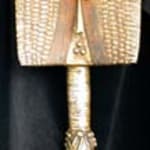Kota Mahongwe Janus Reliquary Sculpture, 20th Century CE
Brass Plated Wood
23
PF.6228 (LSO)
This dramatic deconstructed anthropomorphic piece is a reliquary figure made by the Kota people of Gabon. It is a rare variant, with two identical faces, one on either side of...
This dramatic deconstructed anthropomorphic piece is a reliquary figure made by the Kota people of Gabon. It is a rare variant, with two identical faces, one on either side of the spade-shaped head. The basic structure of the piece is wood, which has been overlain with metal wire and plate. The “handle” of the spoon is partially plain wood, and partially wound around with wire and geometrically decorated metal strips. The ground of the face is textured like textile, with a central bar running down to the centre where the eyes are situated. The slender nose is delineated with a hair-like double bar of textured metal – resembling a moustache – that runs down to the jawline past the mouth, denoted with three circular dots. There is a wide band of coiled wire beneath the neck, followed by a band of metal decorated with raised diagonal lines.
The Kota live in Eastern Gabon, and are comprised of various subunits including Ndambomo, Mahongwe, Ikota-la-hua, Sake, Menzambi and Bougom, some of which can also be differentiated artistically (see below). Their society is largely egalitarian and gerontocratic, their economy based upon hunting and agriculture. Their relaxed social structure reflects their previous mobility – they moved into the area from the North during the 18th century – which is also perhaps the cause behind their unusual mortuary rituals in which they were basically able to take their ancestors with them wherever they went. It is also reflected in the comparatively small number of large items in their cultural repertoire, as transporting unwieldy items would have posed logistical problems.
The Kota originally exposed their dead, but started to bury them following influence from neighbouring groups. The remains (especially skulls) of prominent personages were then exhumed and placed into baskets (Bwete), which were defended by carved figures decorated with metal plates or wire. Their eyes were always prominent, to symbolise watchfulness to protect ancestors from harm, and also to symbolise their watchfulness for their living descendents. There is considerable stylistic variation due to the geographical distribution of the subgroups, and together they are among the most famous and recognisable symbols of African art. Their radical deconstructivism of the human form had an enormous influence on the 20th century development of Western art styles, and exert a powerful fascination to historians of African art.
There are six forms, based around the proportions of the face, the nature of the wire/plate metal and the superstructures, such as headpieces or superfluous decoration. By not being covered primarily with strips of brass (originally cut from colonial food plates), possessing a wire-bound form, a truncated almond-shaped face and a handle-like eminence atop the head, this piece is most likely to be made by the Mahongwe (also known as the Osseyba). Almost all Kota pieces are rare as many traditional practices – including masquerades and the reliquary system – have been either suppressed or have gone out of fashion. To compound matters, many older items were intentionally destroyed in the 1940’s to 1960’s by the “Culte de Demoiselles”, who went out of their way to destroy traditional lifeways in an attempt to mimic western lifestyles.
This is a dramatic and impressive piece of African art.
The Kota live in Eastern Gabon, and are comprised of various subunits including Ndambomo, Mahongwe, Ikota-la-hua, Sake, Menzambi and Bougom, some of which can also be differentiated artistically (see below). Their society is largely egalitarian and gerontocratic, their economy based upon hunting and agriculture. Their relaxed social structure reflects their previous mobility – they moved into the area from the North during the 18th century – which is also perhaps the cause behind their unusual mortuary rituals in which they were basically able to take their ancestors with them wherever they went. It is also reflected in the comparatively small number of large items in their cultural repertoire, as transporting unwieldy items would have posed logistical problems.
The Kota originally exposed their dead, but started to bury them following influence from neighbouring groups. The remains (especially skulls) of prominent personages were then exhumed and placed into baskets (Bwete), which were defended by carved figures decorated with metal plates or wire. Their eyes were always prominent, to symbolise watchfulness to protect ancestors from harm, and also to symbolise their watchfulness for their living descendents. There is considerable stylistic variation due to the geographical distribution of the subgroups, and together they are among the most famous and recognisable symbols of African art. Their radical deconstructivism of the human form had an enormous influence on the 20th century development of Western art styles, and exert a powerful fascination to historians of African art.
There are six forms, based around the proportions of the face, the nature of the wire/plate metal and the superstructures, such as headpieces or superfluous decoration. By not being covered primarily with strips of brass (originally cut from colonial food plates), possessing a wire-bound form, a truncated almond-shaped face and a handle-like eminence atop the head, this piece is most likely to be made by the Mahongwe (also known as the Osseyba). Almost all Kota pieces are rare as many traditional practices – including masquerades and the reliquary system – have been either suppressed or have gone out of fashion. To compound matters, many older items were intentionally destroyed in the 1940’s to 1960’s by the “Culte de Demoiselles”, who went out of their way to destroy traditional lifeways in an attempt to mimic western lifestyles.
This is a dramatic and impressive piece of African art.



